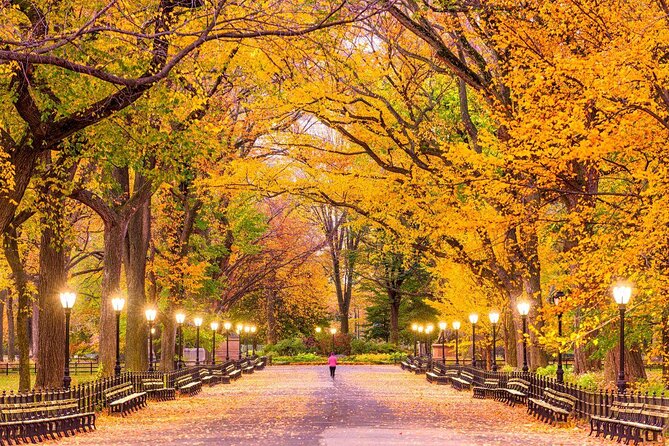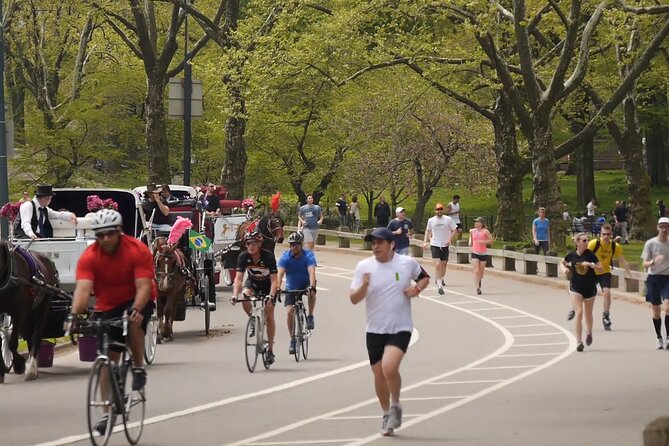Central Park stands as a testament to the vision of its creators, Frederick Law Olmsted and Calvert Vaux. Their design transformed a chaotic urban landscape into a serene retreat, merging nature with community space. This incredible feat not only provided a sanctuary for city dwellers but also set a standard for parks globally. Yet, the park’s story extends beyond its design; it intertwines with history, culture, and the ever-evolving relationship between nature and urban life.
Good To Know

- Central Park was designed by Frederick Law Olmsted and Calvert Vaux to offer a natural retreat from urban life in Manhattan.
- The park features innovative landscapes with meandering paths, lakes, and open meadows that encourage exploration and community engagement.
- As the first landscaped public park in the U.S., Central Park symbolizes democracy and accessibility in urban planning.
- Its diverse ecosystems support over 230 bird species and 21 natural ponds, creating a vibrant environment for wildlife.
- Central Park prioritizes accessibility for all visitors, with wheelchair access, public transport options, and a commitment to inclusivity.
The Visionaries Behind Central Park
Although many New Yorkers enjoy Central Park today, its creation was the result of visionaries who sought to transform a chaotic city landscape into a serene oasis.
Figures like Frederick Law Olmsted and Calvert Vaux championed the idea of a public park, believing it would provide much-needed respite from urban life. They envisioned a space where people could connect with nature, fostering community and well-being.
Their innovative designs incorporated meandering paths, picturesque landscapes, and diverse recreational areas.
This groundbreaking project not only changed the city’s fabric but also set a precedent for urban parks around the world, forever altering public space in America.
Find more activities and experiences we've covered in New York City.
Exploring the Design and Landscape
The innovative design of Central Park reflects the vision of its creators, Olmsted and Vaux, who aimed to blend natural beauty with functional space. Their approach transformed a chaotic urban environment into a harmonious oasis. This balance of landscapes encourages relaxation and recreation, allowing visitors to escape the city’s hustle.
| Design Element | Description |
|———————|——————————–|
| Water Bodies | Lakes and streams enhance tranquility. |
| Pathways | Meandering paths invite exploration. |
| Open Meadows | Spacious areas for gatherings and leisure. |
| Tree Canopies | Diverse flora offers shade and beauty. |
Historical Significance of Central Park

Central Park holds significant historical value as it symbolizes a pivotal shift in urban planning and public space use in America.
Designed in the mid-19th century, it was the first landscaped public park in the United States, embodying ideals of democracy and accessibility. The park not only provided a green oasis amidst urban chaos but also set a precedent for future parks across the nation.
Its creation marked a move away from overcrowded city life, emphasizing the importance of nature in urban environments. Central Park’s innovative design influenced city planning and public recreation, making it a landmark in American history.
Wildlife and Natural Features
As visitors stroll through Central Park, they often encounter a diverse array of wildlife and natural features that enhance the park’s charm and ecological significance.
From the serene lakes to the lush woodlands, each corner reveals a unique ecosystem. The park serves as a vital refuge for numerous species, making it a living showcase of nature amidst the urban landscape.
The park’s serene lakes and lush woodlands create a vibrant refuge for diverse species, showcasing nature in the urban landscape.
Birdwatchers can spot over 230 bird species.
The park’s 21 natural ponds support diverse aquatic life.
Over 26,000 trees provide habitat and shade for visitors.
These elements create a vibrant environment that captivates all who visit.
Accessibility and Visitor Experience
While exploring the vast expanses of Manhattan’s backyard, visitors find that accessibility is a top priority in Central Park. The park accommodates everyone, ensuring a seamless experience. Wheelchair and stroller access is widely available, and service animals are welcomed. Public transportation options nearby make getting to the park easy for all.
| Accessibility Feature | Details |
|————————|———————————-|
| Wheelchair Accessible | Yes |
| Stroller Accessible | Yes |
| Service Animals Allowed | Yes |
| Public Transport Nearby | Yes |
| Participation for Most | Yes |
This commitment enhances the visitor experience, making Central Park truly inclusive.
Cultural Events and Activities
Visitors to Central Park not only enjoy its accessibility but also its vibrant array of cultural events and activities throughout the year.
From outdoor concerts to art festivals, the park serves as a dynamic stage for community engagement. Each season brings unique experiences, ensuring something for all.
Shakespeare in the Park: Free performances of classic plays.
SummerStage: Live music spanning various genres.
Central Park Film Festival: Outdoor screenings of beloved films.
These events not only enrich the park’s atmosphere but also foster a sense of community, drawing both locals and travelers to partake in the magic of Central Park.
The Legacy of Central Park
Central Park stands as a testament to urban ingenuity, embodying a legacy that intertwines nature, culture, and community. Over the years, it’s transformed from a simple green space into a vital urban ecosystem. The park’s design fosters recreation, artistic expression, and social interaction, solidifying its role in New York City’s identity.
| Aspects | Impact |
|———————|————————-|
| Nature | Biodiversity and habitat |
| Culture | Artistic inspiration |
| Community | Social engagement |
| Recreation | Health and wellness |
This enduring legacy continues to influence urban planning worldwide.
The Sum Up
Central Park stands as a testament to the visionary design of Olmsted and Vaux, seamlessly merging nature with urban life. Its diverse landscape and rich historical significance continue to inspire visitors, while its wildlife and cultural events foster a sense of community. As Manhattan’s backyard, the park not only offers a serene escape but also embodies the ideals of accessibility and connection for people from all walks of life. Central Park truly remains a cherished legacy for generations to come.
More Tour Reviews in New York City
Looking for something different? Other New York City activities we've written about
- 2 Day Niagara Falls Tour from New York
- D.C.,Niagara Falls,Boston 5-Day Tour from New York
- Central Park Pedicab Tour Top Highlights
- Pedicab 1 Hour Central Park Tour
- Statue of Liberty Direct Sightseeing Cruise
- 45 min Long VIP Central park carriage ride
- See 30 Top New York Sights (Walking Tour) & Go Up The Empire State Building!
- Over 30 NYC Sights in One Tour – Kids Join Free!
- 3-Day Niagara Falls,NY and Boston Tour from New York
- Liberty Sightseeing Cruise and Manhattan Top Sights Walking Tour
- American Dream One Day Fun Day Dreamworks Waterpark 4-in-1 Pass
- 6 Iconic Audio Tours & City Guide App plus AI Question + Answer
